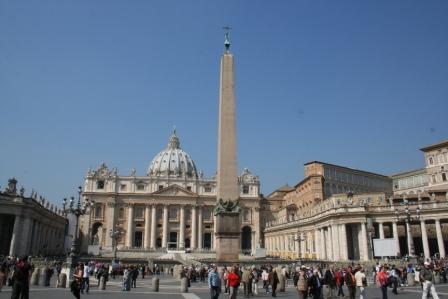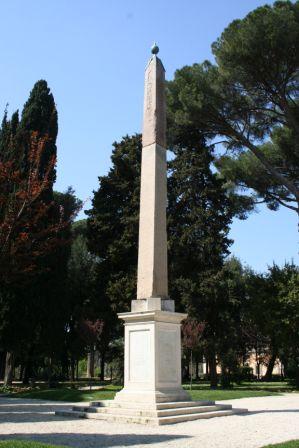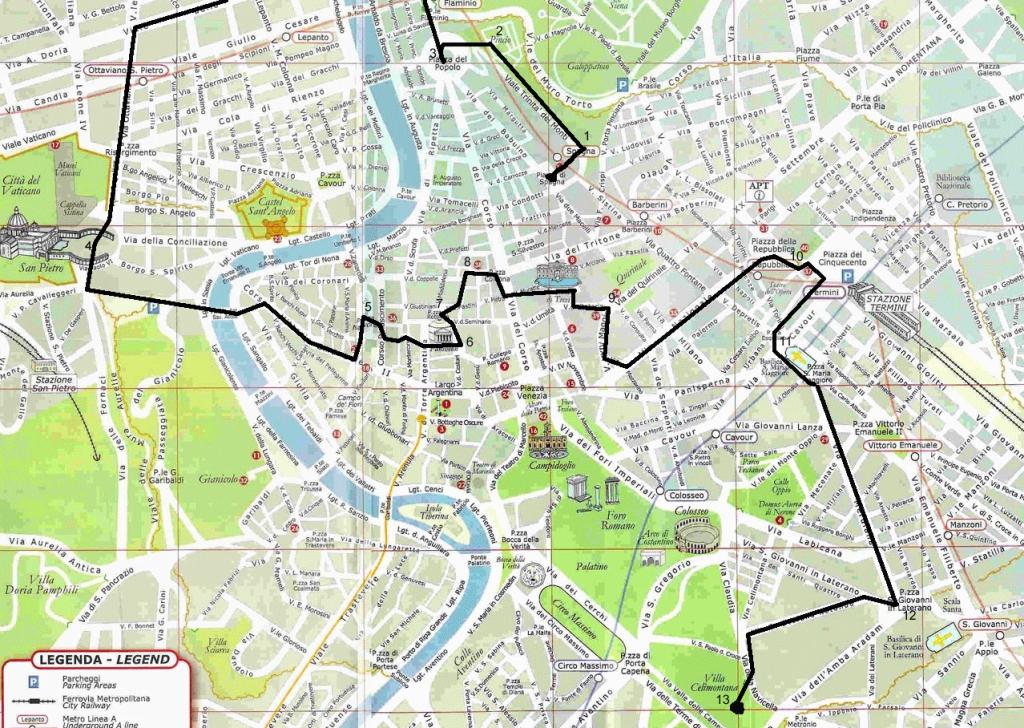
PART ONE
As a good friend and colleague living in Rome has demonstrated to me, it is possible to do the entire tour on foot in also around 3 hours (in a different order - click here for the route he followed). This though is not really recommended for a hot day, or for anyone with less than the stoutest constitution - or an equally stout pair of shoes…
Since however it is the aim of this site to try to ease the strain wherever possible by making use of public transport, you will hopefully find that the following itinerary is somewhat easier on the feet….
Places of outstanding interest mentioned in the notes have been printed in red (with a few recommended stops for refreshment in orange) - but there are plenty of other sights along the way…!
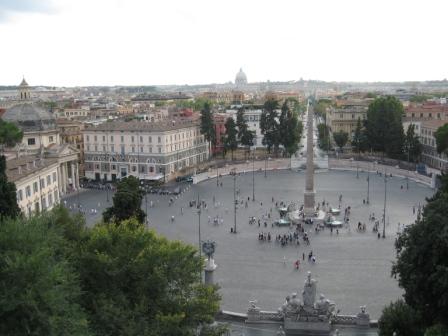
Use the links in the box below to take you to the sections on each obelisk individually - and a few of the other locations.
Click here to see a more detailed map of this first part of the route (opens in a new window).
1. Trinita dei Monti Obelisk
Villa Medici
2. Pincio Obelisk
Piazzale Napoleone
3. Piazza del Popolo Obelisk
S. Maria del Popolo
Piazza del Popolo
4. Vatican Obelisk
Tram Rides
Piazza S. Pietro
Bus 64
Towards Piazza Navona
5. Piazza Navona Obelisk
Piazza Navona
East of Navona
6. Piazza della Minerva Obelisk
7. Piazza della Rotonda Obelisk
The Pantheon
1. TRINITA DEI MONTI Obelisk
The journey begins in the wonderful Piazza di Spagna. This can easily be reached on Metro Line A (for more info on the square itself and the Spanish Steps, see "Talking Statues").
Our first obelisk stands in front of the twin bell-towers of the French church of SS Trinita dei Monti, at the top of the Scalinata stairway. Make your way to the top of the steps (there is a lift at the entrance to the Spagna Metro station if you want to save as much breath as possible for later...!)
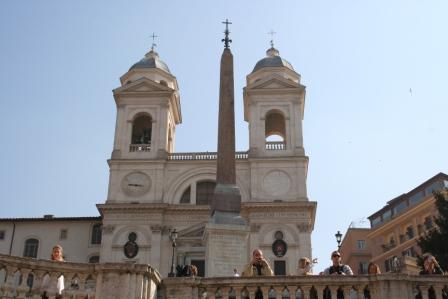
This obelisk is one of the "home-made" Roman ones - with inscriptions copied from the one coming up soon in Piazza del Popolo; although rather badly copied, as the Roman craftsman didn't understand the hieroglyphics he was reading and carved some of them upside-down. It is believed to have been commissioned under the Emperor Aurelian in the third century, and stood in the famous Gardens of Sallust (a historian writing at the end of the Republican era) before it collapsed and was apparently carted out to lie beside the Porta Salaria. It was later acquired by the Ludovisi family, who had it repaired and moved to the Lateran Basilica; but it was thought to be too out-of-place beside its much taller 'brother' there. Eventually Pope Pius VII had it erected in its present position in 1789. Visible at the top are some fleurs-de-lys, reflecting its French connection with the church behind it. As we shall see, this is far from the only obelisk which has 'travelled well' across the city!
The church of the Trinita itself is an unmistakable landmark with its twin bell-towers and double staircase, and is well worth visiting. It belongs to the French Order of Minims: the main part of the church is often closed off for the private use of the nuns. Look out inside for some frescoes by Volterra, including his much-praised 'Deposition from the Cross', and also one said to contain a figure which is a portrait of his friend and mentor Michelangelo.
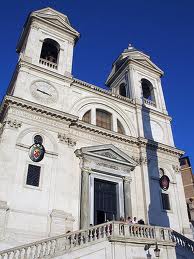
From the top of the Scalinata, turn uphill to your left; as well as being able to admire fabulous views over the northern part of the city, you will soon reach the Villa Medici.
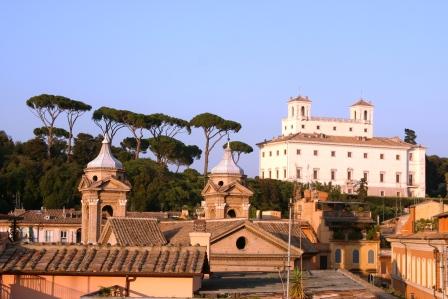
After obtaining this beautiful house for their 'Escape to the Country' - they certainly got the location, location right! - the famous Florentine dynasty created some lovely gardens behind their Villa (the house itself is not generally open to the public) which are regularly open to visit in guided groups. In 1801, Napoleon 'acquired' it for the Academie Francaise, making it available to the artists and composers who had won the Prix de Rome to use as the base for their studies in the city: such stellar names as Debussy and Berlioz lived here in the same apartments that their modern successors can still use today - though they no longer have to win a prize first.

In fact, the garden does contain a small obelisk! It is not however an 'original', but a copy (neither Egyptian nor Ancient Roman, so it doesn't count…) made of one which now stands in the Boboli Gardens in Florence (the actual 'twin' of which we shall meet later on).
In front of the villa stands a large shallow fountain dish with a jet of water 'fired' from a central cannon-ball orb (see "Respighi's Rome").
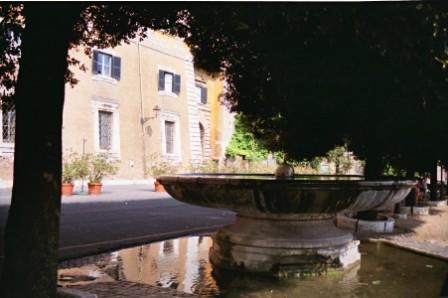
Continue up the slope, bearing slightly to the right. The other large villa-like building you pass is the Casina Valadier, named after the important architect responsible for many projects during the early nineteenth century, including the redesigning of Piazza del Popolo below you. It is now a (rather expensive) café-restaurant. A short distance further on brings you to the edge of the Pincio park, connected to the gardens of the Villa Borghese (see "A Ride on Bus 116"). To your left opens up the famous terrace, the Piazzale Napoleone I, to which you can return in a moment; first, on your right, however, you should now be able to see Obelisk #2.
2. The PINCIO Obelisk
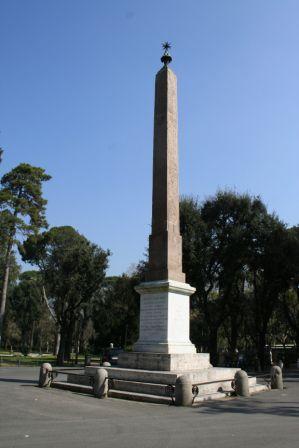
This spire, bare of any carving on the shaft itself, is another of the ancient Roman examples. It was commissioned by the Emperor Hadrian in the second century to adorn the tomb of his beloved Antinous, who had drowned in the Nile whilst saving Hadrian's own life - a dedication can be read on the pedestal. In the early third century it was transported to Rome by the Syrian teenage emperor Elagabalus (one of the craziest and most debauched of them all - it is surprising how little-known he is, compared, say, with Nero or Caligula) and it probably stood in the Circus Varianus near to where now stands the Basilica of S Croce in Gerusalemme. It was later acquired by Pope Urban VIII, who wanted it to stand in front of the Palazzo Barberini, but no-one got round to putting it up, and since it was obstructing the traffic (!) it was moved to the Cortile del Pigna in the Vatican by Clement XIV. Finally Pius VII had it erected in its present position in 1822.
It makes a lovely centrepiece to the attractive Pincio Gardens behind it (whose other interesting features include the busts of famous Italians you can see in all directions, and a Water-Clock fountain, now restored and working again...sometimes...)
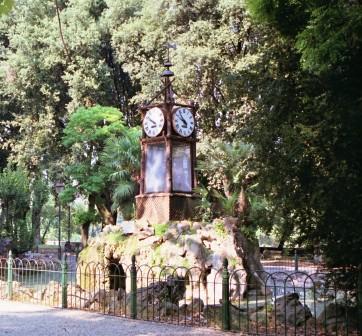
Here once were situated the Gardens of Lucullus, the famous republican general and epicure whose wealth was as legendary as his appetite for pleasure - aesthetic and culinary; a generation or so later they were acquired by the Emperor Claudius for his wife Messalina: notorious for her appetites for even more physical pleasures, she finally took one lover too many, and after she had performed a drunken 'marriage' with him here on the hill, her still-besotted husband was eventually persuaded to order her arrest and decapitation.
Head back towards the terrace. Its views over the Piazza del Popolo and further across the city to the dome of St Peter's are rightly celebrated; it is still, as it has been for centuries, a special trysting-place for romantics from all over the world, especially as the sun sets and the scene is bathed in a warm golden glow. Across to the right, you should see, leading down, a steepish stairway.
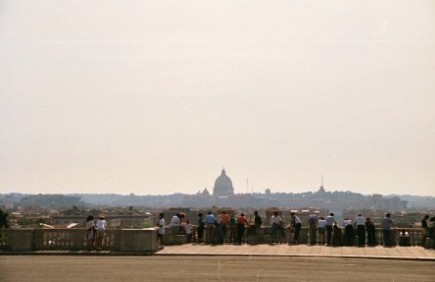
As you walk down here, there are various interesting statues and corners to admire: you can get a side-view of the powerful jets of a fountain, a sight really designed to be seen from the square below; another twist of the path brings you up against part of the Aurelian wall built along the edge of the park here, known as the Muro Torto - look out over the top to see the busy Piazzale Flaminio. From below on the outer side the wall has long looked in imminent danger of collapse (hence its name: "Twisted"), but when even in ancient times it was suggested that it needed shoring up, a Roman legend was found, declaring that it was under the personal protection of St Peter himself. He's continued to do a good job ever since.
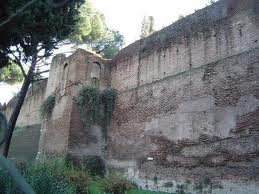
Round one more twist beside another glorious old fountain basin - reminiscent of those brought from the Baths of Caracalla (if only it would work one day!) - and you will find on your right a staircase leading down beside the wall of a church. This is the important foundation of S Maria del Popolo. For further information about the interior treasures of this church, see "Respighi's Rome" (or for an unsurprisingly incomplete description, try a well-known novel by Mr D. Brown). For now, there is just one tale about it that I will mention here.
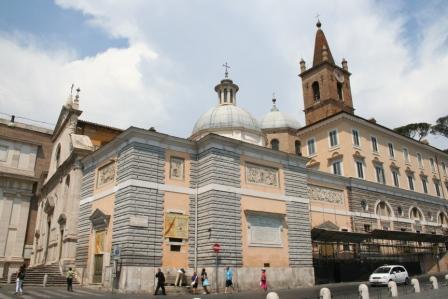
On this spot, so it was believed, the Emperor Nero committed suicide (with the help of a loyal freedwoman) as he fled from the soldiers who had plotted to dispose of him and replace him with the experienced (but short-lived…) general Galba. Some walnut trees were supposed to have been planted over his grave, which became the haunt of a flock of crows, said to be the manifestation of the black soul of the late tyrant himself flying around the city bringing bad luck. To exorcise the malignant spirit, in 1099 Pope Pascal II ordered the grove to be cut down and the place re-sanctified with the building of a chapel. Later a 'parish' church (the original meaning of the title 'Popolo' in the church's name) was set up by Gregory IX, the forerunner of the new foundation by Sixtus IV in the 1490s which is still here today.
At the bottom of the stairway you are of course in the Piazza del Popolo, with the third of our targets towering unmissably at its centre. This will be the first one so far actually to have been an Egyptian original.
3. PIAZZA del POPOLO Obelisk
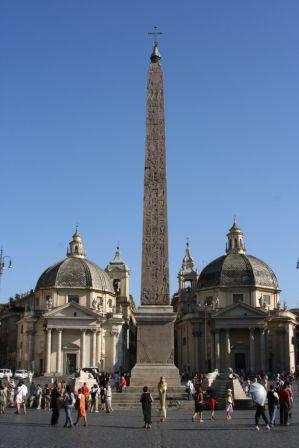
It was Rameses II who set up this great monument, at the Temple of the Sun in Heliopolis. The carved inscriptions and cartouches commemorate this great ruler. In 10 AD, the emperor Augustus had it transported to Rome (making it the first one to be brought to the city); no doubt he felt it was appropriate 'spoil' after the defeat of Antony and Cleopatra - it certainly started a trend!
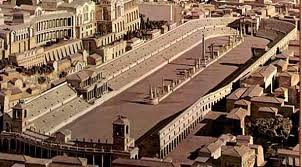
Augustus placed it along the 'spina' (long central barrier) of the Circus Maximus (to be later joined by another we shall see further on). When Sixtus V had it excavated and re-erected here in 1589, it was the fourth that his by now well-practised architect Domenico Fontana had set up in as many years. Not many of the other obelisks have had so few homes! Beneath it, the appropriately Egyptian carved lion fountains were added by Valadier in 1823, when he redesigned the whole square.
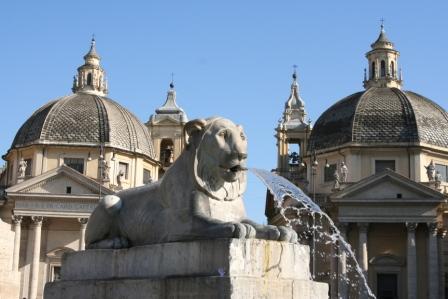
The Piazza itself must be one of the grandest 'front doors' of any city anywhere. Originally set out by Manetti in the mid-1500s for Paul II, it is enclosed on one side by more of the Aurelian Wall, with the Porta Flaminia affording a magnificent entry-point for travellers approaching from the north. The gate's structure, standing pretty much on the site of the ancient original, was remodelled by Alexander VII in 1655 for the arrival of Queen Christina of Sweden - who was obviously so impressed that she settled in Rome permanently! On either side are two monumental tableaux of sculpture (not to mention the fountain you passed on your way down - the furthest reach of the Aqua Vergine aqueduct); and leading off toward the city centre are the 3 streets known collectively as 'Il Tridente': from left to right Via del Babuino (see "Talking Statues"), the Corso, and Via di Ripetta, which once ran along the Tiber banks and was home to the city landing-docks.
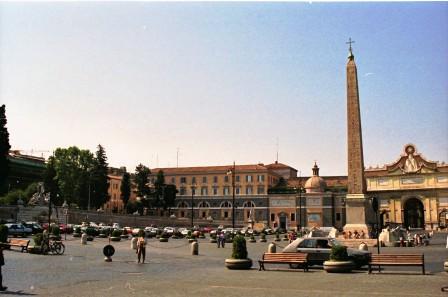
Flanking the Corso on either side (looking towards the city centre) are the 'twin' churches of S Maria in Montesanto (left) and S Maria dei Miracoli (right). Several architects (including Bernini) had a hand in them, but it was mainly due to the skill of Carlo Rainaldi that these two actually rather different churches appear to look the same. To prove otherwise, study the shape of the cupolas, the bell-towers and the lay-out of the window-openings below the domes. Both are worth visiting: S Maria dei Miracoli often hosts evening concerts, and S Maria in Montesanto - should you be lucky enough to find it open - contains an unusual modern representation of the 'Supper at Emmaus' by Ferroni, where the disciples appear in modern dress, and Jesus seems to be eating his fish-and-..bread…out of a newspaper!
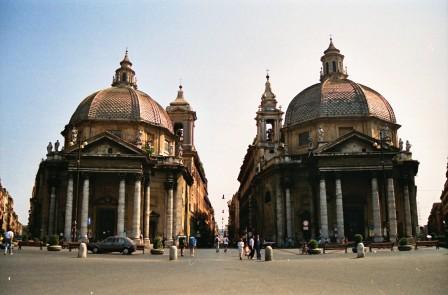
If you are in the mood by now for a quick caffe, also opposite each other are two famous but very different café-restaurants. Far left is 'Canova', and far right 'Rosati': the latter retains a very attractive old-fashioned 'Liberty-style' feel and décor, whilst the former has had a (fairly) recent refit into a more modernist form of 'art-deco' look with lots of glass and mirrors. Take your pick.
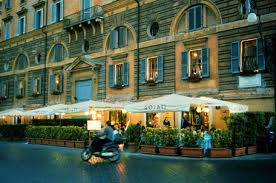
To get to obelisk #4 - following our present route at least - you now need to entrust yourself to one of the more endearing ways of getting around the city: the tram. Two, in fact! Firstly head out through the Porta Flaminia and cross the very busy Viale del Muro Torto. This shouldn't take you more than an hour or so…actually (fortunately) this is traffic-light controlled, even if it does still seem to take a very long time for the lights to favour pedestrians (you could go underground instead - but it won't make much difference). Directly ahead of you is one terminus of Tram 2.
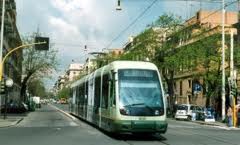
These are 'frequentissimi': the next one is always arriving as one leaves. A normal bus ticket is valid for your journey (see "Roman Transport Systems"), so settle down to enjoy the ride - but not for long (the first proper stop in fact, not counting a possible hold-up at some lights): at the junction with Via Azuni (or more strictly, Piazza della Marina) on the left, you need to alight, hop across to the other platform, and wait (hopefully for no more than about 10 minutes) for Tram 19 to approach from the opposite direction.
This time you will have a bit longer to appreciate this wonderful form of transport. It will take you across the Tiber over the Ponte Matteotti, and then rattles along the straight streets of the Prati region (mainly down Viale delle Milizie), turns down past the Ottaviano Metro station (the nearest you'll get to the Vatican that way) to a much closer point of arrival - its terminus at the Piazza del Risorgimento. This is now mainly used for the trams; it used to be where the inevitable Bus 64 started and finished. It is only a 5-minute walk up the Via della Porta Angelica to St Peter's Square.
4. S PIETRO Obelisk
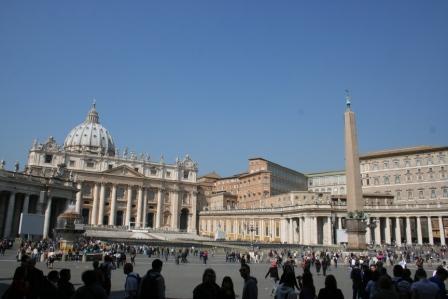
This is not the place to start describing the Vatican. The Piazza di S Pietro is more than enough for now. Much of the vast grandeur is of course down to Bernini (who else..?), and you mustn't miss trying out his clever trompe l'oeil trick of standing on one of the two special flagstones where the 4 rows of enormous columns appear to merge into one; nor should it just be followers of Mr D. Brown who enjoy making their way around the compass-point pavement-carvings of the Winds (not actually the work of Bernini anyway). But the real hero, for us on this tour at any rate, has to be Sixtus V's engineer-architect Domenico Fontana - the man who found the way to re-erect this massive central obelisk (and then went on to raise 3 more) - with, as legend has it, a little help from a certain nameless Genoese sailor…
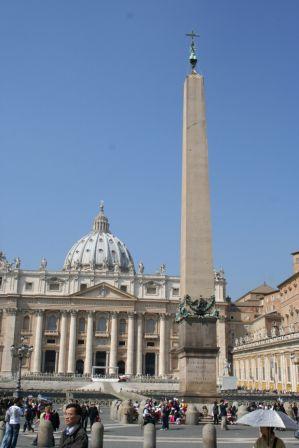
The obelisk was another import from Heliopolis; although Augustus first only moved it as far as Alexandria. It was brought to Rome in 37 AD by his great-grandson Caligula, who set it up once again as the adornment of a Circus which is believed to have lain just to the south of the current piazza. It may indeed really have been here that Peter was martyred under Nero: the traditional description of this happening 'between two Metae' - a 'meta' being the name of the turning-point cone-shaped markers at each end of a Circus's 'Spina' - lends attractive credibility to this idea. When Constantine destroyed the circus to build the first version of the Basilica, he retained the obelisk at the side of the new church - it had long been said that the bronze globe at its peak contained the ashes of Julius Caesar himself. But in 1587 Sixtus V planned to move it.
Such a feat had been declared impossible - even by Michelangelo. But Fontana wasn't put off: with much measurement and experiment he devised an intricate system of ropes and pulleys, first to pick up the shaft from its old position - the only obelisk never to have fallen since ancient times - and then to manoeuvre it into place in the centre of the square. Vast crowds assembled for the day of reckoning: the Pope heightened the tension by commanding silence, on pain of death. The huge spire was arranged in front of the deep pit dug to receive it. As the ropes tautened to lower it in, and the frame began to creak and buckle under the strain, it began to look as though the whole structure was in danger of collapse; but suddenly, defying the Pope's order, out of the crowd came the voice in Ligurian dialect of an old seaman: "Water on the ropes!" Fontana's crew sprang to follow his idea, and the project was saved. Or so the story goes.
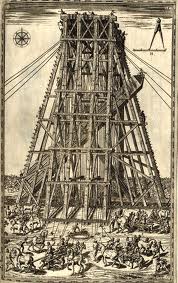
Incidentally, Sixtus decided to remove the bronze globe (far too pagan) and replaced it with a cross. On inspection, to see if it really did contain Caesar's ashes, Fontana discovered that it had been cast in one piece, and so nothing could be inside it. There were, however traces of 'bullet' holes and other damage that was believed to have occurred when the invaders at the Sack of Rome had used it for target practice!
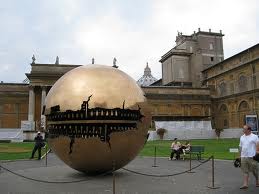
It'll take a big effort to tear yourself away so soon (the queues are bound to be too long, anyway…), but to leave the square, head over opposite to where you came in, thread yourself between the columns, and follow the road (actually called Piazza del Sant'Uffizio) that leads away to the south on a slightly upward slope - practically where the obelisk must originally have stood, in fact. You will soon see the entrance going underground to the coach-park; carry on past this to the main road running right to left ahead of you - the grandly named Galleria Principe Amedeo Savoia Aosta! To the left, it goes into an underpass - and just before it does, on the opposite side of the road, is a bus-stop. Aim for this, and it will certainly not be long before a faithful Bus 64 arrives.
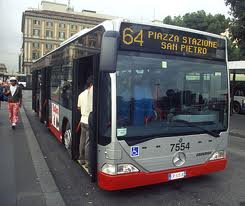
This particular route, running at the moment from the S Pietro railway station through to Termini, used to have the reputation of being not only crowded, but also a favourite for pickpockets. It's still likely to be crowded, but I haven't seen any sign of the thieves for a few years now: the city has definitely cleaned up its act over the last decade - the Millennium celebrations were the spur. Unless you're very unlucky (or careless) you probably won't come across the legendary 'children with the piece of cardboard', or 'woman with the baby strapped to her front' (in both cases leaving hands hidden beneath free for dirty work). So you'll be safe enough now to sight-see, as the bus takes you back towards the city-centre.
When the bus emerges from the underpass, it soon crosses over the Ponte Principe Amedeo (Savoia Aosta…), and after one more short stretch it heads off along the Corso Vittorio Emanuele II (see "A Ride on Bus 116"). This end of town there's not that much to view; but the big church set back behind a 'soup-tureen' fountain on the left is the Chiesa Nuova, a unusually airy and spacious affair with a double organ, sharing a dedication to S Maria in Vallicella with one also to St Philip Neri, the patron saint of Rome, and the founder of the Philippine Oratory next door, where his followers held concerts and gave us the term 'Oratorio'.
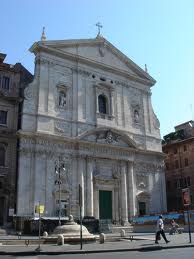
Get off at the next stop after the church and cross the road when you can - it may be wisest to walk up to the pedestrian lights at Via dei Baullari, as you will want to head inwards opposite here anyway. The Museo Barracco at this turning, in the mistakenly named Piccola Farnesina palace (it has no connection with any of the other Farnese foundations) contains some interesting antique sculpture.
Once across the road, go directly ahead down Via della Cuccagna towards the site of Obelisk #5. Instead of going straight there, however, make a tiny detour by turning right down the Vicolo della Cuccagna. You will emerge into Piazza dei Massimi, beside a rather forlorn single column. Look up at the wall of the palace in front of you, on whose façade you can still - just - make out a series of fresco paintings in plain black and white, like an architectural comic-strip; it has been very sad for me to watch it gradually fading away to almost nothing even over the 5 decades I have been visiting. How the inhabitants themselves can bear it, I have no idea. This is actually the back of the Palazzo Massimo, which is where St Philip Neri is said to have performed his famous miracle of restoring a young boy of the family to life (long enough to hold a conversation, anyway...). If you go to the palace on March 16th, you will be allowed in to see the chapel - in the distinguished company of many of the family's friends and relations. This is the only day in the year that any of the palace is open.
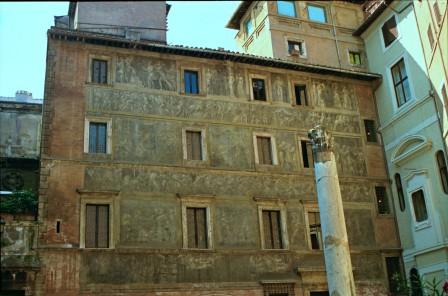
Turn sharp left around the column, the sole survivor from Domitian's "Odeion", built for music and poetry recitations, then walk up a short way ahead, and you will find yourself in the amazing Piazza Navona.
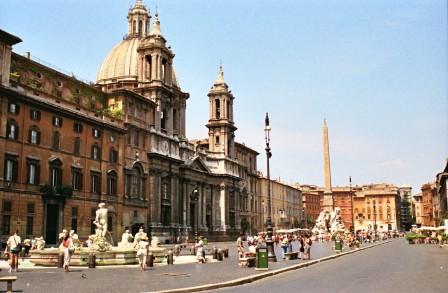
It is (or should be!) impossible to come to Rome and not visit this square. No matter what time of day or night you visit, it is always a rewarding experience - and perhaps that reward may be to find that you have it for once almost to yourself! There is something about the shape, the three fountains in perfect symmetry and the striking architecture that surrounds it that makes it unforgettable and always a delight to revisit. It has a different persona, and different attractions, after dark; here by day, with the sun, hopefully, flashing around the water-jets and the artists and street performers taking time out for a gelato before their evening work starts in earnest, you can get a better look at the overall scene around you.

The shape, of course, comes from its original construction again by the Emperor Domitian (whom, however paranoid and insecure he may have been personally, we can certainly thank for some terrific surviving monuments) as a Circus - probably for athletic events rather than for chariot races. This also explains the derivation of the name: 'contests' came via Greek into the Latin language as 'agoni', so the 'Campus Agoni' eventually evolved into 'n'Agona' and so 'Navona'. The area was never built over, the banks of seats being gradually replaced by the buildings that we see today (imagine what the Circus Maximus could look like if the same had happened there!) You can still see remains of the entrance gateway of the original circus behind the far end (and how far ground-level has risen since).
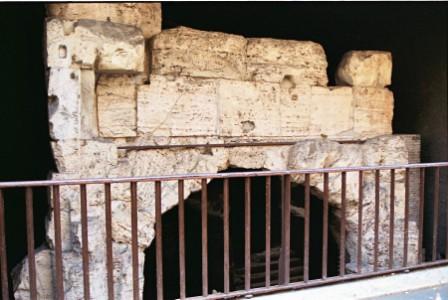
As late as the nineteenth century the whole piazza was occasionally flooded (usually deliberately…) and mock 'sea-battles' or naval race events were held.
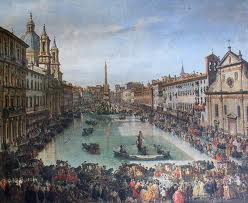
We owe most of the decoration on view today to Pope Innocent X; before his improvements it was used as a marketplace. His Pamphilj family palace, south of the church of S Agnese, is now the Brazilian Embassy; outside it, he commissioned Bernini first to restore the Fountain of the Moor (built in the previous century) at the near end - the Fountain of Neptune at the far end was only constructed in the 1800s - and then to build the famous Fountain of the Four Rivers at the heart of the piazza.
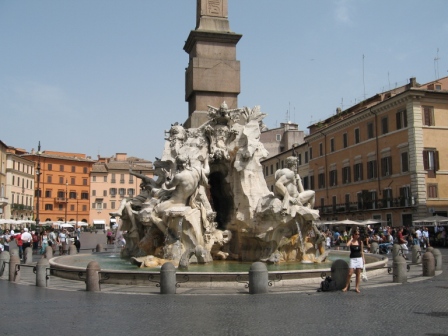
Before looking at the actual obelisk, have a walk around this astonishingly dramatic creation and look at the figures representing the Rivers themselves: the Danube, Plate, Ganges and Nile - the latter with his eyes covered to reflect that at that time its source was still unknown. Even if Bernini may have left some of the actual carving to his students, there is no disguising the brilliance of his overall design, especially how the obelisk appears to stand almost weightless over empty space below.
5. PIAZZA NAVONA Obelisk
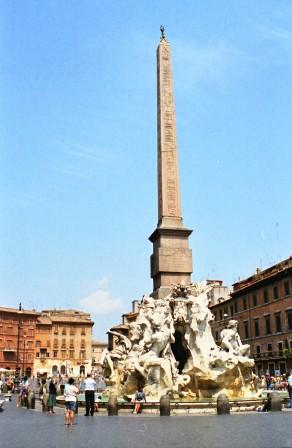
This fifth of our spires was carved in Egypt at Domitian's orders during the latter part of the first century, and then shipped to Rome to decorate his Temple of Isis. The inscription commemorates not only him (described as 'Eternal Pharaoh') but also his father and brother, the emperors Vespasian and Titus. Later, in 311, the emperor Maxentius moved it out of town to stand on the spina of the circus he'd built beside the Appian Way, where it lay amongst the ruins for many centuries. To complete his re-arrangement of the piazza, Innocent had it crowned with the Pamphilj emblem (the dove) and let Bernini do the rest. It was a rather appropriate return: to another stadium, and this time the one built by its original 'owner'.
One of the more amusing stories told about the astonishing effect Bernini produced, whereby it seems to be hanging in the air, is how one of his jealous detractors tried to scare the Pope into believing that it had been set up wrongly and was about to collapse. The architect was summoned: taking the briefest of looks, he looped a thin length of string around the shaft, attached the other end loosely to a building opposite, and set off home whistling cheerfully, leaving everyone agape. This wonderful (and still un-collapsed at this moment in time) monument has recently been cleaned and restored, and is once again on view as pristine as it originally looked on its completion in 1651.
The church of S Agnese in Agone (retaining the original name of the square rather more obviously) has a façade by Bernini's rival, the dour Borromini; his gloomy temperament belied by his being responsible for some of the most delicate and attractive pieces of architecture in the city. Inside, the various architects involved have succeeded in creating an almost 'Tardis'-like sense of space, with its wide expanse crowned by a tall cupola (done by Rainaldi).
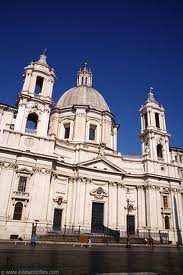
You can descend to the Oratory of St Agnes, built at the original construction of the church in ancient times over the spot where the young saint was martyred - but not before she had miraculously grown long hair to conceal herself after being thrown naked into a brothel (not an uncommon extra attraction for those visiting the Circus). The oft-quoted (by tourist-guides to their gullible customers) tale of Bernini showing his disdain for his rival's façade by having one of his 'Rivers' apparently recoiling in horror and shielding his face is, unsurprisingly, apocryphal: Borromini didn't complete the front of the church until after the fountain was finished.
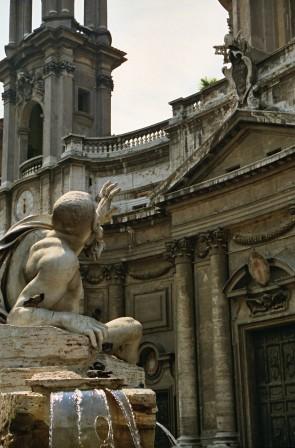
Most of the square is fringed with restaurants of varying quality, but similar expense. To be recommended, though, is 'Tre Scalini', where, even if it doesn't serve the best gelato in the city overall, does offer an unbeatable trademark 'tartufo'.

For a less expensive and probably more satisfying full meal, it is better to try one of the places a street or two off to the west: if you take the road beside 'Tre Scalini' (ignoring the garish touristy places that line it) and cross one more road, you will reach Via di Parione - a lovely old street leading (to the right) to the beautiful church of S Maria della Pace (to be described elsewhere), and (to the left) to various small trattorie offering proper Roman cooking - a personal favourite is 'Virginiae' where the chefs, well-trained by their now sadly deceased Mama, still produce her trademark roast lamb with rosemary (Abbacchio alla Romana), which is out of this world.
The next part of the trail, taking in the next four obelisks, has to be done on foot, but it isn't an arduous walk, and (as ever) there is a lot to see or pass in the process. Leave Piazza Navona by the road leading out midway up to the right - past the 'patch' of Marcelo, Rome's greatest 'living statue'.
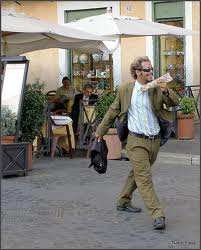
You will emerge on the busy Corso del Rinascimento. Cross over and head down to the right (or vice versa). On either side of the turning you now want (Via degli Staderari) are 2 interesting buildings. On the left is Palazzo Madama, named after Holy Roman Emperor Charles V's love-child who was 'installed' there out of the way. It is currently the seat of the Italian Senate - the modern-day 'Curia', and not nearly so attractive as its ancient forerunner.
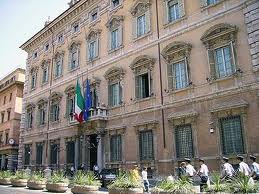
Much more pleasing - although its pearl is hidden away within its courtyard - is the Palazzo della Sapienza on the right, giving its name to the University of Rome which was once situated here. Some of its rooms are used for exhibitions. At the back of the courtyard stands Borromini's lovely church of S Ivo, with its twirly 'bee-sting' cupola (built for the Barberini Pope Urban VIII, whose family emblem was the bee). It is only open on Sunday mornings, but has a refreshingly calm, white and understated interior, a real oasis from the traffic on the main roads outside.
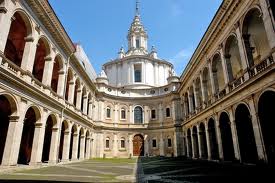
Walk down the Via degli Staderari. On the right is one of Rome's most recent fountains (it was only built in 1927), and very nice it is too, with a double pile of books, perhaps representing the University libraries, flanking the stag-antlers of the rione you are now entering, that of Sant'Eustachio.
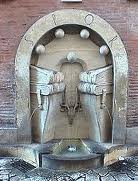
It is into the piazza named after this saint that you now emerge, past a rather larger fountain-basin: this most probably came from the Baths of Nero, a large complex, with few traces now remaining, which occupied a site just a little to the north. Almost opposite you is 'the best caffé in Rome' or at least the café which serves it. Try it! You'll have the chance very soon to compare it with its main rival, a few squares away. If you're not sweet-toothed, ask for yours to be served 'senza zucchero', because otherwise it'll come 'ready-mixed': most Romans tend to take their shot of coffee with an almost equal amount of sugar, and Sant'Eustachio (Il Caffe) saves them the trouble of tearing open the packet.
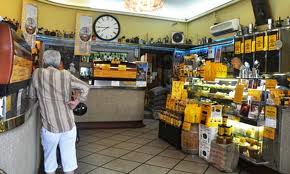
The eponymous church is around the corner to your left. It is, to be honest, nothing special - even a bit gloomy perhaps. Keep to the left, around the right side of the church, along Via della Palombella, which travels along the back of the Pantheon - you'll get to the front in a minute or two! On its back wall here are some surviving decorations possibly from a Basilica of Neptune, comprising part of Agrippa's huge complex of public colonnades stretching over this part of the Campus Martius (see "A Ride on Bus 116"). Ahead of you is the piazza of the next obelisk.
6. PIAZZA della MINERVA Obelisk
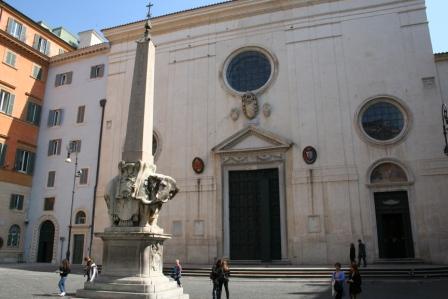
This has to be the most identifiable of them all, perched as it is on the back of a wisely-smiling elephant's back. It is an Egyptian original with connections to Psammetichus II, from the northern city of Sais, one of a group of possibly as many as twelve that were brought to decorate the Temple of Isis built by Domitian; from where it has never strayed far, found in the garden of the Dominican monastery attached to the church next door: the temple stood very close to this area. It was set up here in 1667 by Pope Alexander VII, on a design by Bernini. The inscription reads: 'You need a Strong Mind to support Solid Knowledge'; rather ironic really, since Bernini's 'solid knowledge ' about weight support, already demonstrated with the Four Rivers obelisk was challenged by one of the Dominican friars whose design had been rejected. He insisted that the stomach of the elephant should have an extra block below it for support. This can still be seen from behind; the fact that Bernini pointed the rear of the elephant - with its tail moved aside to emphasise the insulting aspect - directly at the convent is probably no coincidence!
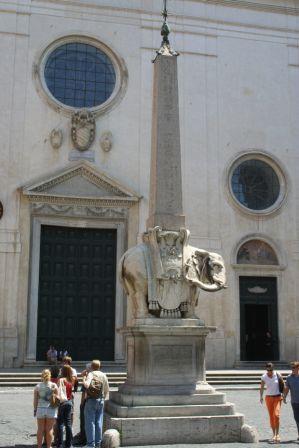
Today the monument is often nicknamed 'Minerva's Chick'; in fact this comes from a confusion of the Italian word 'Pulcino' with 'Porcino' (pronounced in dialect they sound almost the same): it should strictly be 'Minerva's Piglet' (or possibly 'Minerva's Mushroom?')!
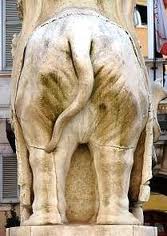
The church beside it is S Maria sopra Minerva (for more brief info on this church see "A Ride on Bus 116"). On the façade of the church you can see 'tide-markers' showing the height the water reached over various years in the piazza during the appalling floods of the earlier centuries.
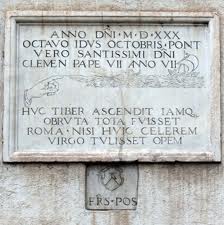
Turn to the left, once again along the side of the Pantheon. For a quick bite, there is an above-average 'pizza a taglio' place on your right, also serving lunchtime pasta dishes. You are now entering Piazza della Rotonda, named of course after the most astonishing and complete ancient temple surviving in the city - if not the world: the broad-domed Pantheon.

I apologise for bringing you into the square from this direction - to get a better first view of this wonderful building almost any other street in would have been preferable. If you can restrain yourself, try to walk straight ahead to the far side of the square before you turn to look…it'll be worth it!
The old Roman proverb that "he who visits Rome without seeing the Pantheon goes and comes back an ass" (an untranslatable pun on 'Rotonda') is entirely endorsed by this website. It is simply one of the most unforgettable buildings in the world, not least through the effect of its massive bulk outside in contrast with the apartments around it; but also thanks to the airy heights of the dome inside.
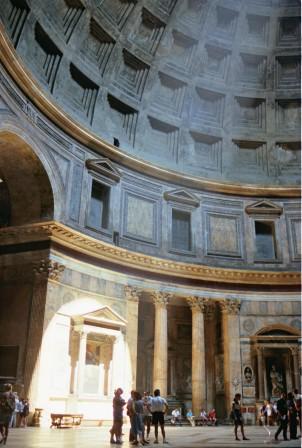
The first thing that strikes one, though, looking from the outside is not the dome - from the front it is scarcely visible - but the portico with its enormous granite columns and low stretched tympanum above. The famous inscription, that 'M Agrippa made it', is well-known to be misleading: the whole temple was redesigned a century later, quite possibly by the emperor Hadrian himself. All the guide books will explain how cleverly the weight of the dome - the widest until the last century - was managed; they will describe the interior, with its 9-metre oculus, the niches for ancient statues, the original marble floor. Certainly it is informative to know all this. But there is nothing to beat just looking at it, being in it, experiencing a sense of wonder that something so magnificent exists - and has survived so long.
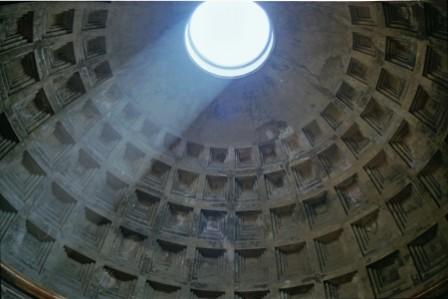
The piazza outside it has seen more changes. It was probably at least four times the size, stretching out over the Campus Martius as again part of Agrippa's overall design of the area. But for us now the important thing is that it is home to obelisk #7.
7. PIAZZA della ROTONDA Obelisk
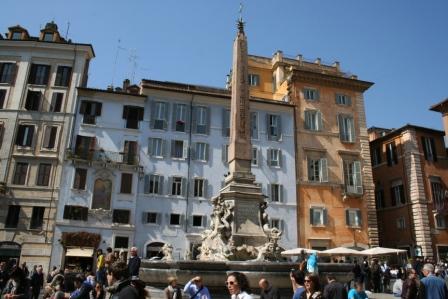
This shares a very similar history to that of the previous one you have just seen. Inscriptions on it link it to Rameses II (making it much older than the Minerva obelisk), but it was again brought over for the Iseum, said to have been close to the site of the nearby church of S Macuto, beside which it was re-erected in 1374. In 1711 Pope Alexander VIII decided to have a fountain constructed in the piazza with the obelisk on top - partly to imitate Bernini's Four Rivers. Both this and the previous one also share the feature of a pointed star at the top, part of the emblem of the Chigi family; strangely, however, because it was only Alexander VII who belonged to this family, rather than both Popes.The gargoyle fountain-heads are a popular subject for photographs!
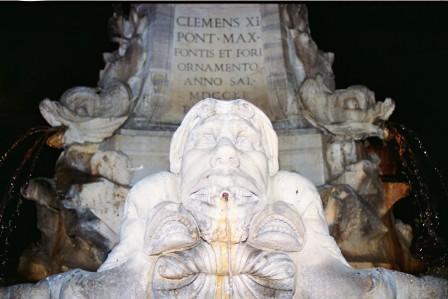
Now is your chance, before leaving Piazza della Rotonda, to put to the test the coffee rival of Sant'Eustachio. At the far right corner as you face away from the Pantheon is the Caffe Tazza d'Oro. If you think this is better…well, that's your perogative...

TO BE CONTINUED......
Timings:
These are the approximate walking/bus-ride times, Obelisk to Obelisk, without stopping much longer than the time it takes to look at the thing! (As actually walked/ridden by the author)
Piazza di Spagna - Pincio: 15 mins
Pincio - Piazza di Popolo: 15 mins
Piazza di Popolo - St Peter's (by trams): 35 mins
St Peter's - Piazza Navona (by Bus 64): 20 mins
Piazza Navona - Piazza della Minerva: 8 mins
Piazza della Minerva - Piazza della Rotonda: 5 mins
Piazza della Rotonda - Piazza Montecitorio: 10 mins
Piazza Montecitorio - Piazza del Quirinale (via Trevi Fountain): 20 mins
Piazza del Quirinale - Piazza della Repubblica (by bus): 15 mins
Piazza della Repubblica - Piazza del'Esquilino (by bus): 8 mins (walking time much the same)
Piazza del'Esquilino - Piazza S Giovanni (by Bus 714): 20 mins
Piazza S Giovanni - Villa Celimontana (by Bus 117): 10 mins
Alternative Walking Routes
A. (Grazie mille to RCG)
1. Piazza del Popolo
2. Pincio (8 mins)
3. Trinita dei Monti (10 mins)
4. Quirinale (19 mins)
5. Repubblica (18 mins)
6. Esquilino (8 mins)
7. S Giovanni (32 mins including 10 min coffee stop)
8. Celimontana (15 mins)
9. Montecitorio (38 mins)
10. Pantheon (4 mins)
11. Minerva (4 mins)
12. Navona (7 mins)
13. S Pietro (23 mins)
B. The Author's suggestion (untimed, I'm afraid)
1. Celimontana
2. S Giovanni
3. Esquilino
4. Repubblica
5. Quirinale
6. Trinita dei Monti
7. Pincio
8. Piazza del Popolo
9. Montecitorio
10. Pantheon
11. Minerva
12. Navona
13. S Pietro


































